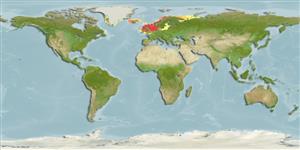Actinopterygii (ray-finned fishes) >
Perciformes (Perch-likes) >
Ammodytidae (Sand lances)
Etymology: Ammodytes: Greek, ammos = sand + Greek, dytes = anyone that likes immersions, diving (Ref. 45335).
Environment / Climate / Range
Ecology
Marine; brackish; benthopelagic; depth range 10 - 150 m (Ref. 35388), usually 10 - 150 m (Ref. 35388). Temperate, preferred ?; 73°N - 49°N, 54°W - 60°E
Northeast Atlantic: 74°N (Novaya Zemlya and Bear Islands) to 49°N (Channel Islands, western English Channel), including eastern Greenland, Iceland, Barents Sea (but not the White Sea) and the Baltic (but not the Gulf of Bothnia and Finland).
Length at first maturity / Size / Weight / Age
Maturity: Lm ?, range 11 - ? cm
Max length : 25.0 cm TL male/unsexed; (Ref. 232); max. reported age: 10 years (Ref. 35388)
Short description
Morphology | Morphometrics
Dorsal
spines
(total): 0;
Dorsal
soft rays
(total): 56-63;
Anal
soft rays: 29 - 33. Scales absent from a median band anterior to the dorsal fin and from the musculature at the base of caudal fin. Belly scales loosely arranged, not in chevrons. Vertebrae 65-75. Margins of dorsal and anal fins straight with rays of equal length. Lateral line pores linearly arranged along the unbranched canals.
This schooling species is usually territorial and burrowing (Ref. 40). Feed on plankton. High activity is correlated to periods with strong tidal currents; then they leave their bottom hides and form large shoals. During low light intensity (night and winter) they bury in the bottom (Ref. 35388).
Muus, B.J. and J.G. Nielsen, 1999. Sea fish. Scandinavian Fishing Year Book, Hedehusene, Denmark. 340 p. (Ref. 35388)
IUCN Red List Status (Ref. 115185)
CITES (Ref. 94142)
Not Evaluated
Threat to humans
Harmless
Human uses
Fisheries: commercial
Tools
Special reports
Download XML
Internet sources
